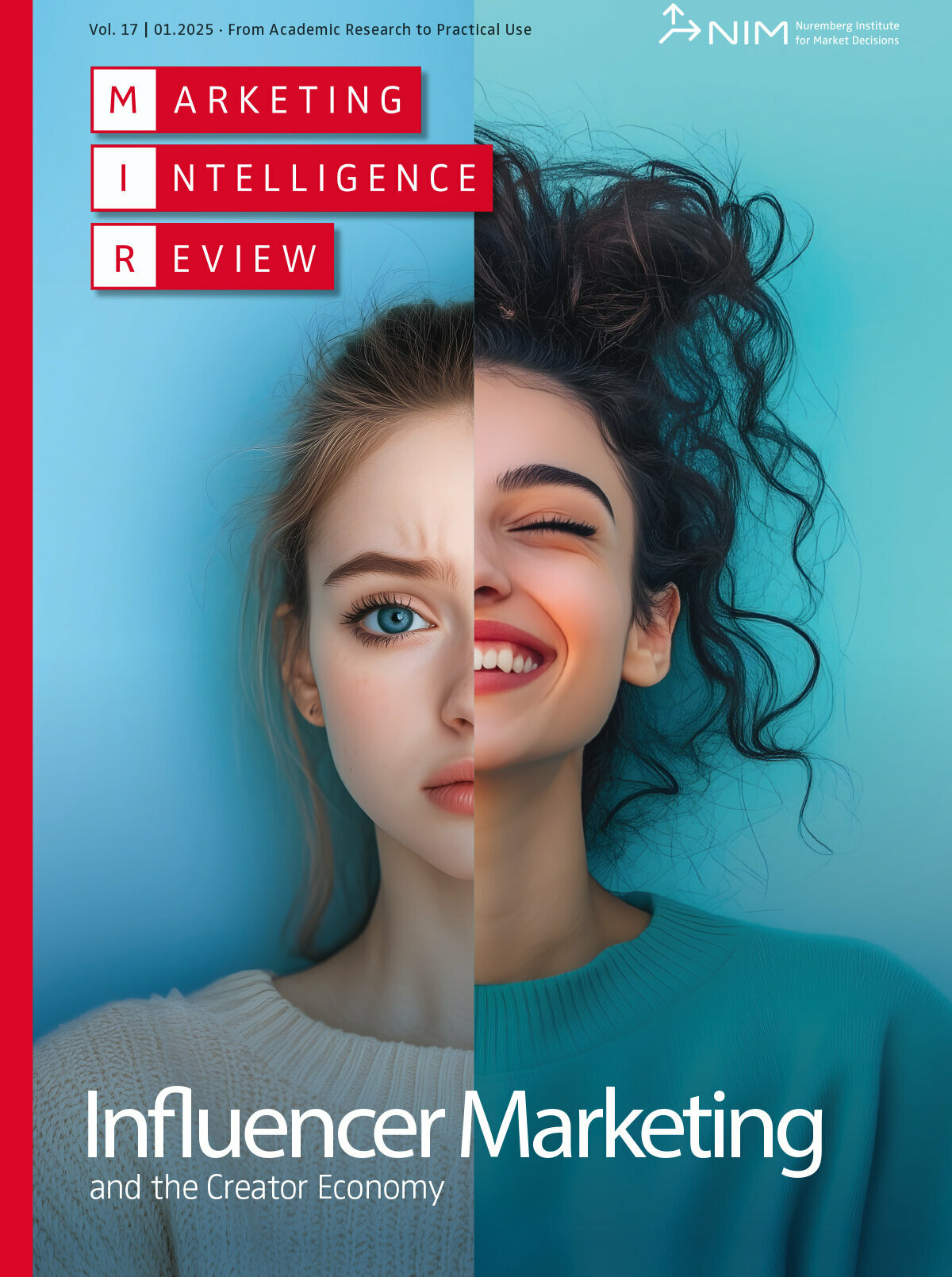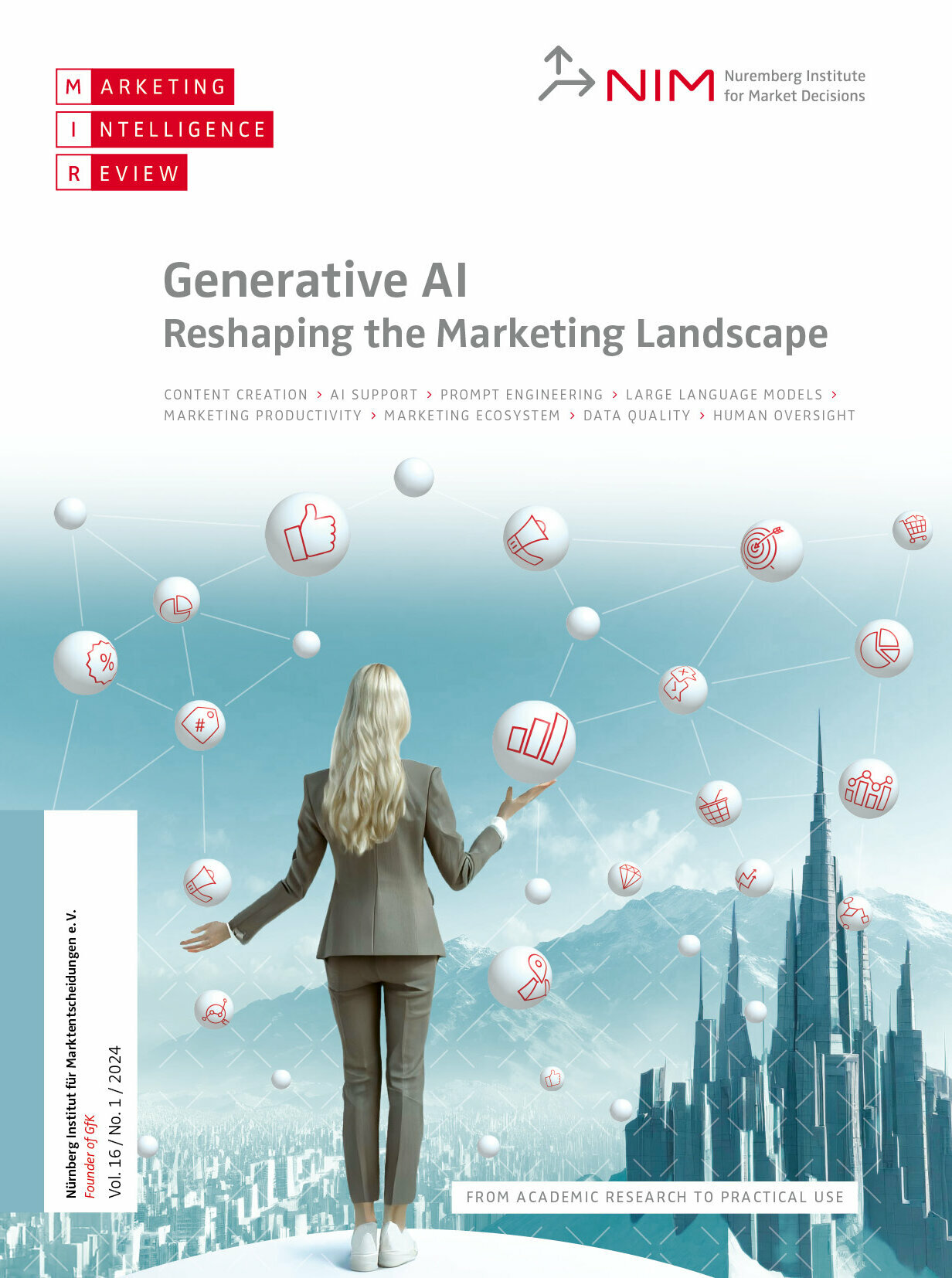Ethical textile consumption: Only a question of selflessness?
Certain strategies can help minimize the gap between consumers’ willingness to purchase items and their moral standards in respect to fair-trade clothes.
Yes, but ...
Would you buy a T-shirt if you knew that it had been manufactured under inhumane conditions? Most people would probably say “no.” At the same time, in terms of hard sales numbers, fair trade clothing still leads a niche existence. According to figures from the GfK Fashion & Lifestyle textile panel, in the first three quarters of 2015, only around one in four consumers in Germany bought at least one article of clothing with an eco-label such as Fair trade, GOTS or Confidence in Textiles. The percentage of clothing with an explicit fair trade label is still distinctly lower.
So why is it that even after catastrophes like the Rana Plaza collapse in 2014 that left over 1,100 dead, we do not buy fairly produced and traded clothes more often? Certainly, there are consumers who do not care one way or the other about manufacturing conditions even though they may not openly admit it. Some consumers who do care about social standards in manufacturing may lack trust in fair trade labels. Or they feel that the responsibility of enforcing such standards lies with government and not the individual, who cannot do anything to change conditions anyway.
Individual attitudes are one aspect, but there are other reasons for the reluctance to buy. Fair trade clothing is often only available in specialty shops. The selection is smaller and does not appeal to everyone. The often significantly higher price also plays a role. Many cannot or do want to pay more than is necessary. The production facilities are usually very far away, so the suffering of the seamstresses can be easily blocked out. Besides, others usually cannot tell if somebody´s clothing is eco or fair. Therefore, it is not as easy for consumers to create an image for themselves through ethical consumption as it is with the usual designer clothes.
However, what actually moves consumers to buy fair trade or not? Could it be that there are customer segments that more quickly and frequently buy according to ethical criteria than others? Which types of customers have no interest whatsoever in eco products? The GfK Verein conducted a study in order to better understand why there is such a low percentage of fairly traded clothing (see Box 1).
Box 1 - Study: How do fairness and altruism influence the clothing-buying behavior of Germans?
In the summer of 2015, a short representative GfK CAPI-BUS survey on this topic was conducted with around 2,000 German consumers. In addition to sociodemographic data, we asked questions about general personality traits, the importance of different purchase criteria, the willingness to pay and attitudes with respect to fair trade seals. Lastly, we measured altruistic behavior using the dictator game, a concept from behavioral economics.
The dictator game is a simple behavioral economic instrument for testing how altruistic individuals really are. A respondent receives a sum of money, which he may keep or share as desired. Since the monetary consequences are real, the behavior exhibited during the game reflects an actual economic decision. The results are more realistic than those obtained with hypothetical questions that do not have real implications and the risk of bias due to socially accepted answers is smaller. The respondents received €2 from the interviewer for the purposes of the study. They could either keep the money or donate it to a social care center for children in increments of €0.50.
Fair trade and environmental protection have little importance as a purchasing motive
Compared to purchase criteria related to the quality or price of the clothing, environmentally compatible and socially fair conditions play a minor role. For most people (at least 85 %), the most important features they look for in clothes are fit, comfort, good workmanship, ease of care and quality of material. More than 93 % of the respondents are concerned about price and value for money, however only 59 % care about environmental friendliness or socially fair manufacturing and trade conditions. While this percentage is significantly lower, it is still much higher than the panel figure of 25 % of those who bought at least one article of clothing in 2015 with an eco-label as of the time of the survey. Our study therefore confirms the existence of a gap between thought and action. On average, women place more importance on fair trade and environmental protection than men. Furthermore, income also plays a part. High earners are much more likely to take fair trade and environmental protection into consideration than people with an average or lower income (see Figures 1 and 2).
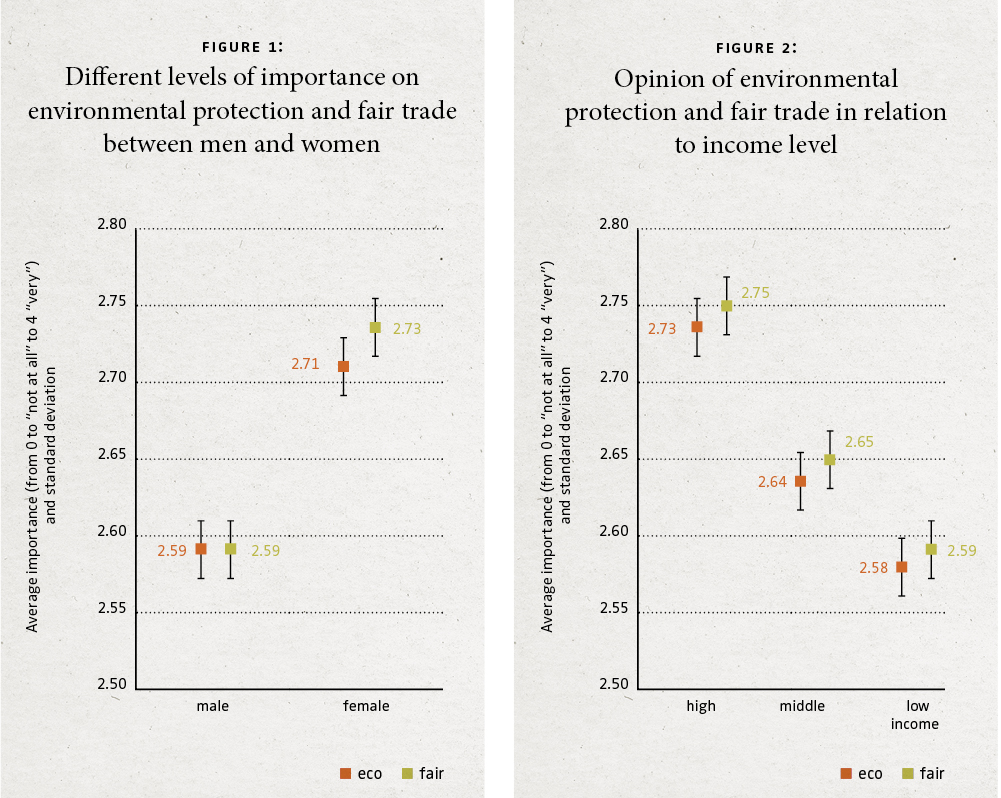
Lack of trust in fair trade seal
Lack of trust in the respective seals may explain the significant difference between actual eco-label-products purchased and the survey results. Nearly half of the respondents (47 %) expressed ambivalence towards fair trade seals. They feel this only makes sense under certain conditions, namely when they are “required for all manufacturers/brands” and “adequately checked and controlled.” Nearly one-third of the respondents (29 %) even have a negative view of the seals and think that they are used to sell clothing at a higher price and an attempt to ease the consumer’s conscience. Only 12 % have a positive attitude towards fair trade seals and have complete trust in them; the remaining 12 % did not give an opinion.
Bias due to socially desirable responding?
Besides the lack of trust in fair trade seals, socially desirable responding could also contribute to the discrepancy between attitudes and actual purchases. In order to investigate this assumption more closely, we invited the respondents to take part in a small game after the survey and observed their willingness to donate money (see Box 1). Across all the respondents, almost half donated the entire €2 available. 27 % kept the entire amount. 23 % kept part of the money and donated the rest (see Figure 3).
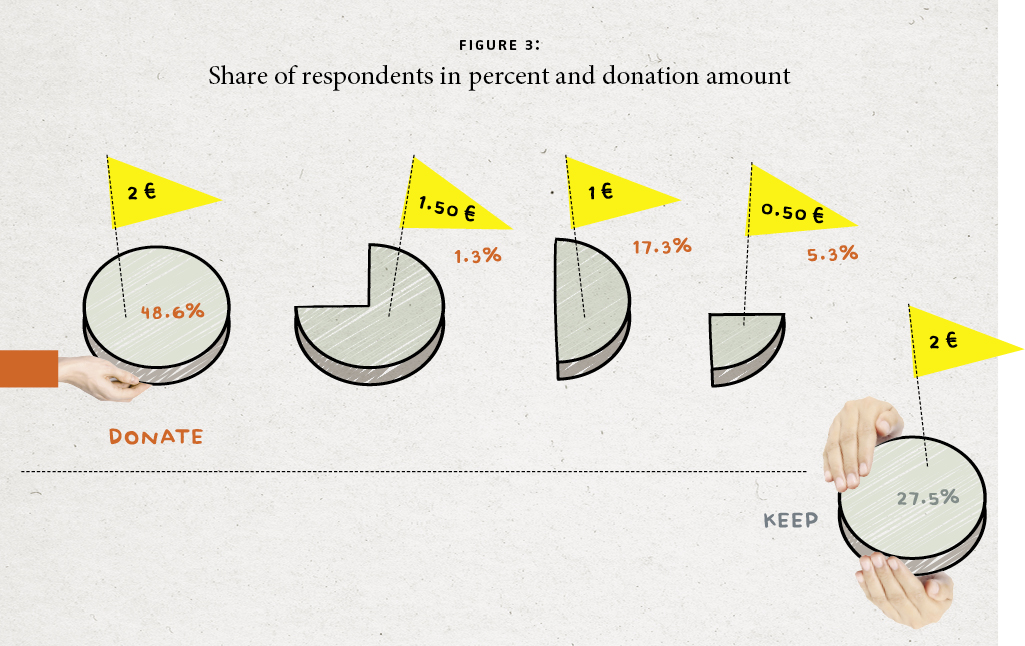
Is the social conscience quicklysilenced when it comes to one’s own wallet?
Despite the gap between actions and words, one cannot make the blanket statement that there is a lack of social conscience. In the dictator game, two-thirds of the respondents still donated at least half of their €2 to a non-profit organization. Some connections (although often weak) were found between donor behavior and the other traits surveyed. The more important the price-related criteria, the lower the donation amount. On the other hand, the donation amount increased in relation to the importance attributed to environmental and fair conditions by the individual. Older people gave more than younger people. The strongest positive connection to donation amount is seen in the willingness to pay. People who spend more for clothing also gave a higher amount to a charitable cause.A factor and cluster analysis of the data gathered resulted in the “Fair Trade Typology” of German consumers described in Box 2.
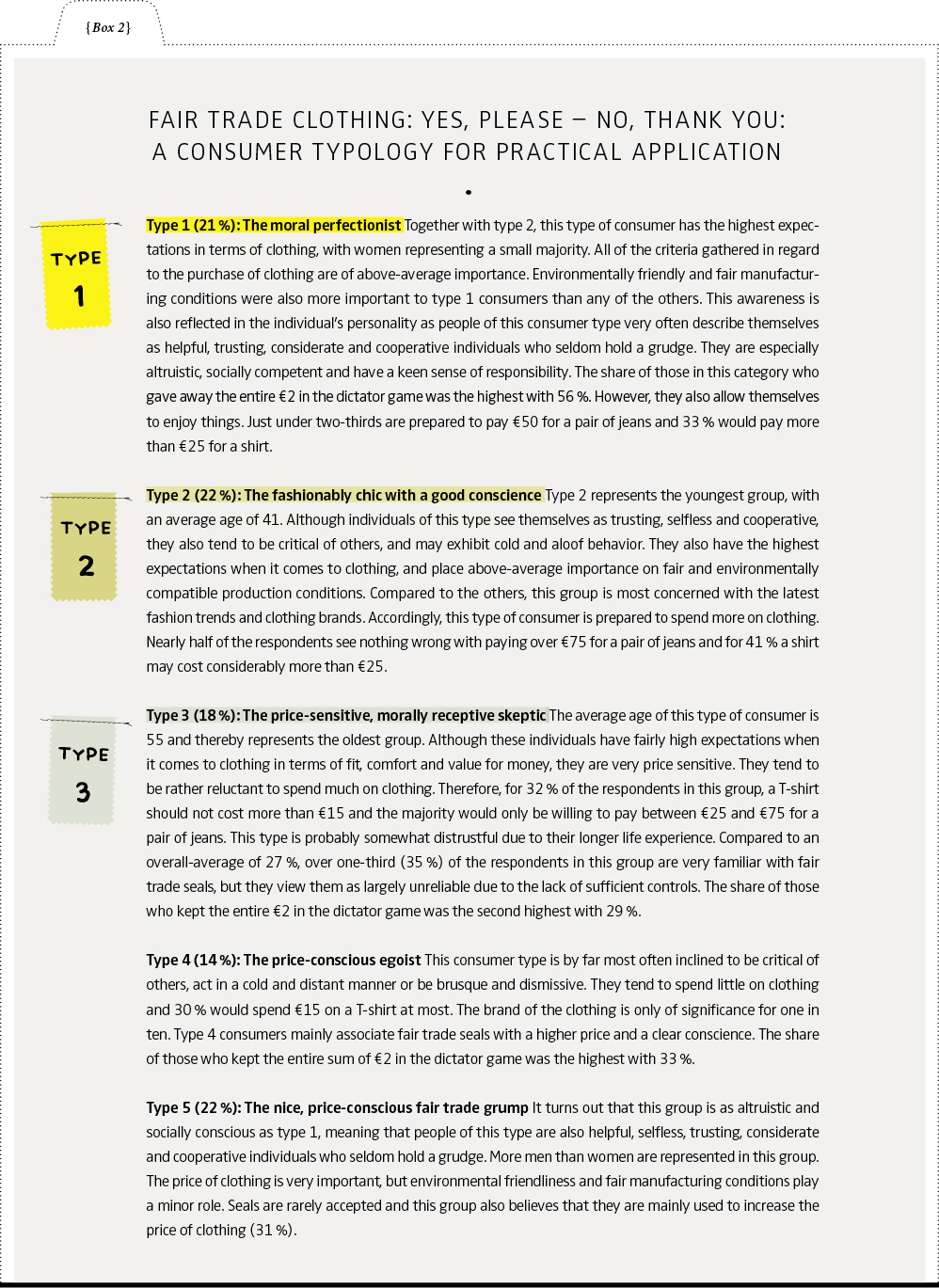
From thoughts to action: Strategies to promote fair textile consumption
Are there now strategies to minimize the gap identified between the willingness to purchase and the moral standards that many consumers set for themselves? Our data and consumer types provide a few promising starting points that are not based on selflessness but rather generate more tangible benefits for the individual consumer groups. At least three of the five consumer types (highlighted in green in Box 2) or two-thirds of the consumers may constitute possible target groups according to our findings.
- Communicate the added value of eco and fair trade products
In particular, the type 1 moral perfectionists and the type 3 price‑sensitive but morally receptive skeptics are open to moral arguments. Brands that communicate the social or ecological effects of their products find a sympathetic audience with these consumer types. Point-of-sale as well as all other communication channels such as brochures, a brand’s homepage or special CSR reports lend themselves to the positive effects of sustainable consumption. - Increase the credibility of eco and fair trade seals
In our survey, nearly half of the respondents said they were critical of certain aspects of fair trade seals such as liability and control. Therefore, measures to increase trust in fair trade seals, like those pursued by the German government’s Partnership for Sustainable Textiles, seem to be promising. - Increase the visibility of sustainable clothing
The currently implemented fair trade and eco-labels are not displayed on the outside of clothes. Particularly with regard to social norms, it is detrimental when inconsistencies between words and actions are not transparent. If ethical purchasing decisions could be noticed by people in the social environment, consumers would be able to distinguish themselves through the consumption of these products. The proposed idea of a visible “green button” or fair trade logo that is openly displayed would give consumers the chance to flaunt their own morals. In addition to type 1 and 3, this strategy could also make buying fairly produced clothing more appealing to the image conscious type 2 consumers and possibly even help to tap into other segments. - Take small steps
Not all those interested in fair trade have strong purchasing power. Even with type 3 consumers, purchasing power and value for money play an important role. Since even minimal amounts per garment can have a significant improvement on the wage rates and living conditions of seamstresses, a “strategy of small steps” is also conceivable. For example, by not immediately focusing on eco and fair in one T-shirt, but on just one factor, small price increases can already do some good. This way, consumers who have less money can also make ethical purchasing decisions and participate in sustainable clothing consumption. However, this strategy also needs to be communicated in a good and credible manner in order to dispel the existing mistrust.
As our study also shows, that limiting the analysis of purchasing motives for ethical consumption to survey data and sales figures can lead us in the wrong direction. We would not have discovered the high percentage of altruistic behavior, as revealed by the dictator game. At the same time, it is known that markets can undermine moral decisions. Behavioral economic experiments that simulate the general conditions and dependencies of the market players in an abstract manner and link them with real monetary incentives can help identify the critical factors and derive new measures.
![[Translate to English:] [Translate to English:]](/fileadmin/_processed_/8/e/csm_16001_mir_01_2016_englisch_Kap1_dadb88483f.png)
![[Translate to English:] [Translate to English:]](/fileadmin/_processed_/4/3/csm_16001_mir_01_2016_englisch_Kap2pdf_d9e83c3451.png)
![[Translate to English:] [Translate to English:]](/fileadmin/_processed_/8/e/csm_16001_mir_01_2016_englisch_Kap3_c40c9643f7.png)
![[Translate to English:] [Translate to English:]](/fileadmin/_processed_/6/d/csm_16001_mir_01_2016_englisch_Kap5_f3ed32e55e.png)
![[Translate to English:] [Translate to English:]](/fileadmin/_processed_/8/1/csm_16001_mir_01_2016_englisch_Kap4_22c9cc47ae.png)
![[Translate to English:] [Translate to English:]](/fileadmin/_processed_/4/7/csm_16001_mir_01_2016_englisch_Kap6_ba0b4ca96c.png)
![[Translate to English:] [Translate to English:]](/fileadmin/_processed_/e/a/csm_vassallo_mir_interview_dec_2015_c0e0fe05d5.jpeg)
